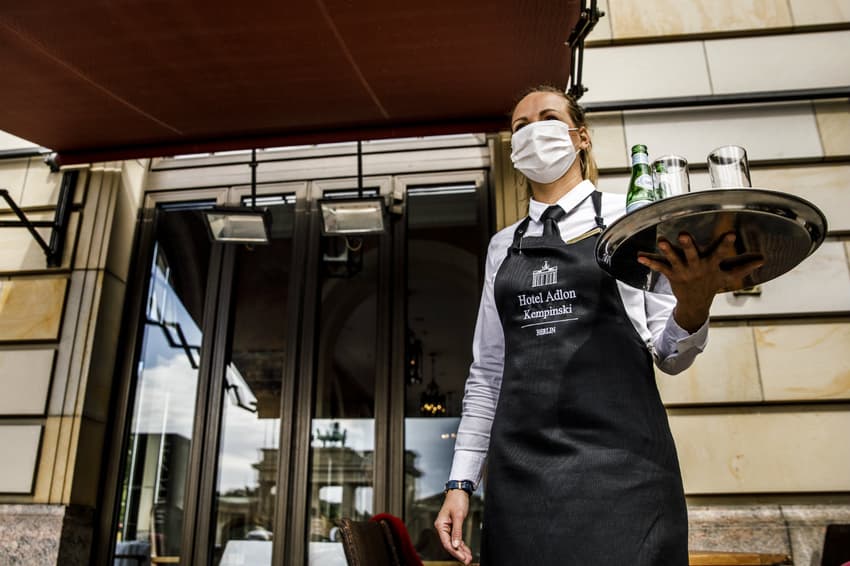Berlin's coronavirus reproductive number is rising. What does it mean?

Berlin's critical R number has risen to 1.37, raising fears that the coronavirus situation is worsening in the capital. But there are other measures to factor in. Here's what we know.
Like other states, Berlin has been easing coronavirus restrictions, with some outdoor swimming pools opening on May 25th after the lockdown.
But news about the reproductive value (the R number or R0) increasing in the capital dominated local media on Monday.
With lots of Berliners gathering by the canal or in parks, it's raised fears of a possible new wave of infections and more lockdown measures.
Berlin's health senator Dilek Kalayci said on Monday that the R number had increased for the third day in a row – although the number of active cases has dropped.
The R0, which shows how many people a person with coronavirus goes on to infect, has risen above the set limit of 1.2, prompting a 'red light' in the capital's coronavirus traffic light warning system.
But there are other indicators that help us see the full picture of the coronavirus situation in Berlin.
READ ALSO: Coronavirus in Germany: Which restrictions are changing from Monday May 25th?
What's the latest?
Kalayci, of the Social Democrats (SPD), told the Health Committee that the reproduction factor in Berlin, is estimated to be 1.37, according to the latest report of Germany's Robert Koch Institute. In the two days before, it had been logged as 1.23 and 1.22.
That means a person with coronavirus on average goes onto infect more than one other person. Experts have repeatedly hammered home the importance of keeping the R0 under 1.
In Germany, the nationwide value is estimated to currently be just under 1.
The reproduction factor shows the trend of new infections – if the value is below 1, the number of new infections decreases; if it is equal to 1, the number remains roughly the same. If it exceeds 1, exponential growth is possible in the long run – and that's what everyone wants to avoid.
The Berlin Senate has introduced a traffic light warning system in a bid to keep checks on the coronavirus epidemic in Berlin. One of the three indicators of the system is based on the R number.
If the R number reaches 1.1, it results in an amber light. If the R0 climbs to 1.2 there's a red light.
Kalayci said that the current R number of 1.37 is the highest value in comparison to all other German states.
"If this continues, we have to worry," Kalayci said.
 Berlin's health senator Dilek Kalayci on April 27th. Photo: DPA
Berlin's health senator Dilek Kalayci on April 27th. Photo: DPA
What happens now?
The Berlin government says it is now observing closely whether the reproduction value fluctuates or settles down.
It's important to keep in mind that the number can fluctuate, especially if the number of new infections is low. In Berlin, the local government reported on Sunday evening a total of 6,641 confirmed coronavirus cases in the capital since the pandemic began, an increase of five new infections from the previous day.
The number of active cases has further decreased from 396 to 390. No new deaths have been reported since Saturday. A total of 191 patients have died from Covid-19 so far in the capital.
READ ALSO: How worried should we be when Germany reports a higher coronavirus infection rate?
As well as the reproduction number, two further indicators are included in the traffic light system: the occupancy rate of intensive care beds and the number of new infections.
According to Kalayci, these two indicators are still green in the traffic light system: the number of new infections is estimated to be five per 100,000 inhabitants per week – the traffic light only jumps to amber at 20.
The proportion of Covid-19 patients in intensive care units is 4.7 percent – the traffic light only jumps to amber at this indicator when there is a 15 percent occupancy rate for coronavirus patients. In total there are 177 people in hospital, with 60 in intensive care.
According to the Senate, action is taken at the latest when two indicators change to red. Mayor Michael Müller says in this scenario, planned relaxation measures can be postponed or new restrictions can even be ordered.
The Senate is set to debate how to further relax measures and open more public life in Berlin on Tuesday May 26th.
They will no doubt take this red light warning into account, but they'll also have to look at the bigger picture of a city that's eager to get back to business.
READ ALSO: Berlin's coronavirus lockdown exit plan - the key dates to know
Comments
See Also
Like other states, Berlin has been easing coronavirus restrictions, with some outdoor swimming pools opening on May 25th after the lockdown.
But news about the reproductive value (the R number or R0) increasing in the capital dominated local media on Monday.
With lots of Berliners gathering by the canal or in parks, it's raised fears of a possible new wave of infections and more lockdown measures.
Berlin's health senator Dilek Kalayci said on Monday that the R number had increased for the third day in a row – although the number of active cases has dropped.
The R0, which shows how many people a person with coronavirus goes on to infect, has risen above the set limit of 1.2, prompting a 'red light' in the capital's coronavirus traffic light warning system.
But there are other indicators that help us see the full picture of the coronavirus situation in Berlin.
READ ALSO: Coronavirus in Germany: Which restrictions are changing from Monday May 25th?
What's the latest?
Kalayci, of the Social Democrats (SPD), told the Health Committee that the reproduction factor in Berlin, is estimated to be 1.37, according to the latest report of Germany's Robert Koch Institute. In the two days before, it had been logged as 1.23 and 1.22.
That means a person with coronavirus on average goes onto infect more than one other person. Experts have repeatedly hammered home the importance of keeping the R0 under 1.
In Germany, the nationwide value is estimated to currently be just under 1.
The reproduction factor shows the trend of new infections – if the value is below 1, the number of new infections decreases; if it is equal to 1, the number remains roughly the same. If it exceeds 1, exponential growth is possible in the long run – and that's what everyone wants to avoid.
The Berlin Senate has introduced a traffic light warning system in a bid to keep checks on the coronavirus epidemic in Berlin. One of the three indicators of the system is based on the R number.
If the R number reaches 1.1, it results in an amber light. If the R0 climbs to 1.2 there's a red light.
Kalayci said that the current R number of 1.37 is the highest value in comparison to all other German states.
"If this continues, we have to worry," Kalayci said.
 Berlin's health senator Dilek Kalayci on April 27th. Photo: DPA
Berlin's health senator Dilek Kalayci on April 27th. Photo: DPA
What happens now?
The Berlin government says it is now observing closely whether the reproduction value fluctuates or settles down.
It's important to keep in mind that the number can fluctuate, especially if the number of new infections is low. In Berlin, the local government reported on Sunday evening a total of 6,641 confirmed coronavirus cases in the capital since the pandemic began, an increase of five new infections from the previous day.
The number of active cases has further decreased from 396 to 390. No new deaths have been reported since Saturday. A total of 191 patients have died from Covid-19 so far in the capital.
READ ALSO: How worried should we be when Germany reports a higher coronavirus infection rate?
As well as the reproduction number, two further indicators are included in the traffic light system: the occupancy rate of intensive care beds and the number of new infections.
According to Kalayci, these two indicators are still green in the traffic light system: the number of new infections is estimated to be five per 100,000 inhabitants per week – the traffic light only jumps to amber at 20.
The proportion of Covid-19 patients in intensive care units is 4.7 percent – the traffic light only jumps to amber at this indicator when there is a 15 percent occupancy rate for coronavirus patients. In total there are 177 people in hospital, with 60 in intensive care.
According to the Senate, action is taken at the latest when two indicators change to red. Mayor Michael Müller says in this scenario, planned relaxation measures can be postponed or new restrictions can even be ordered.
The Senate is set to debate how to further relax measures and open more public life in Berlin on Tuesday May 26th.
They will no doubt take this red light warning into account, but they'll also have to look at the bigger picture of a city that's eager to get back to business.
READ ALSO: Berlin's coronavirus lockdown exit plan - the key dates to know
Join the conversation in our comments section below. Share your own views and experience and if you have a question or suggestion for our journalists then email us at [email protected].
Please keep comments civil, constructive and on topic – and make sure to read our terms of use before getting involved.
Please log in here to leave a comment.